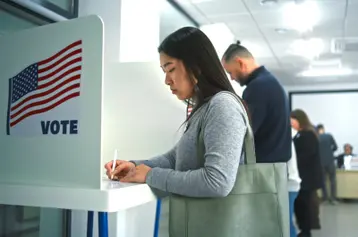Election Season 2024: Ranked Choice Voting Explained

Ranked choice voting (RCV) is spreading across the country. It is currently used in 60 jurisdictions across 24 states, including in party-run primaries, special elections, and RCV ballots for military and overseas voters in federal runoff elections in 6 states (AR, AL, GA, IL, LA, SC). Major cities such as New York City and San Francisco use it for local elections. Utah has an RCV pilot program, where cities must opt in to the pilot program separately for each year that they want to participate. Upcoming implementations include Fort Collins, CO; Portland, OR; Seattle, WA; and six other cities and counties. It is even used by the Academy of Motion Picture Arts and Sciences to select Academy Award nominees and the Best Picture Award.
But what is it exactly? In ranked choice voting, voters rank a first, second, third, fourth and fifth choice candidate for a single office, by order of preference. All first rank votes are counted. Any candidate who receives more than 50% of the first rank is declared the winner. (Compare this with the most commonly used system in the US, plurality voting or first-past-the-post, where the winning candidate need only obtain more votes than any other candidate, i.e., a plurality. But this could mean more than half of voters voted against the winning candidate.) If no candidate receives more than 50% of the first rank, a process of eliminating candidates and transferring votes occurs. The candidate with the fewest first-choice votes is eliminated. Each vote cast for that candidate will be transferred to the voter’s next-ranked choice among the remaining candidates. The second rank only counts when a first rank candidate is eliminated. Your third rank will be counted only if both your first rank and second rank candidates have been eliminated. The elimination process continues until one candidate receives a majority and is deemed the winner.
Why would a jurisdiction adopt ranked choice voting? Both procedural and substantive reasons exist. According to proponents, RCV eliminates the need for expensive run-off elections if no single candidate for a race receives a majority of votes. Because there is no need for a separate run-off election, a winner can be chosen sooner. Procedurally, this makes elections quicker and cheaper.
RCV also reduces problems like vote-splitting, “spoiler” candidates and unrepresentative outcomes that can arise when more than two candidates run for a single position. As the system allows voters to rank a first, second, third, and sometimes a fourth and fifth choice candidate for a single office, it promotes participation, as voters won’t feel like they are “throwing away” their vote by supporting a less popular candidate. If their favorite candidate doesn’t win, at least another satisfactory, second-choice candidate might.
RCV may also lower the barriers to entry into politics for women and candidates of color. A study of recent RCV elections found that voters of color were more likely to rank candidates than white voters, and candidates of color were more likely to win RCV elections, particularly in races featuring multiple candidates. In fact, a 2018 study of four cities with RCV elections found that more candidates of color were elected to office under RCV than the cities’ former election systems. Some possible explanations for this include having only a single, general election; in districts with a white plurality of voters but where several ethnic groups collectively make up the majority, candidates of color have a greater chance of being elected through coalition-building campaigns. Furthermore, campaigns are less costly to run since they are shorter.
In addition, RCV prevents wasted votes. In 2020, voters “wasted” over 3 million votes on Democratic candidates who had already withdrawn from the race, representing over 8% of total votes. (Wasted votes occur when a candidate’s name appears on the ballot after they have dropped out of the race.) Early and mail-in voters are most affected. RCV allows voters to rank a series of backup choices so if their #1 candidate drops out, their ballots are still valid. Because there are no “wasted” votes in an RCV system, mail in and early voting may appeal more to voters, thus reducing costs to support election day activities.
Furthermore, RCV advances nominees with broad support. It incentivizes candidates to build an inclusive campaign and appeal to the broadest group of primary voters – rather than target a single “base” of voters.
It also allows voters to express their honest preferences rather than vote strategically or for the candidate with the best chance of defeating their last choice of candidate. This theoretically should allow more candidates to run who represent a wider swath of viewpoints, since voters can feel free to support third-party candidates without fear of inadvertently helping a candidate they definitely don’t want to win.
Finally, RCV promotes majority support. In elections where more than two candidates compete, candidates often win with less than 50% of the vote. This means that over 50% of voters voted against the winning candidate. Under RCV, only a candidate with a majority of voters’ support wins.
Not everyone is in favor of RCV, though. Five states, all controlled by Republicans, have banned RCV in the last two years: ID, FL, MT, SD, TN. The governor of Alabama recently signed a bill into law that prohibits RCV. Conservative groups argue that RCV is a way to “manipulate elections outcomes” as a way to “ensure left-leaning politicians get elected to office.” Resistance, however, is not strictly along party lines. There’s no evidence the voting system actually favors candidates from one political party over the other. Another argument is that RCV discourages voting by making the process more confusing.
Regardless of how you feel about RCV, or whether or not your jurisdiction uses it, exercising your right to vote is still important! Want more on the topic of civic engagement? Head over to TriNet’s recent blogs on encouraging employees to vote and political discussions in the workplace.
© 2024 TriNet Group, Inc. All rights reserved. This communication is for informational purposes only, is not legal, tax or accounting advice, and is not an offer to sell, buy or procure insurance. TriNet is the single-employer sponsor of all its benefit plans, which does not include voluntary benefits that are not ERISA-covered group health insurance plans and enrollment is voluntary. Official plan documents always control and TriNet reserves the right to amend the benefit plans or change the offerings and deadlines.
This post may contain hyperlinks to websites operated by parties other than TriNet. Such hyperlinks are provided for reference only. TriNet does not control such web sites and is not responsible for their content. Inclusion of such hyperlinks on TriNet.com does not necessarily imply any endorsement of the material on such websites or association with their operators.






